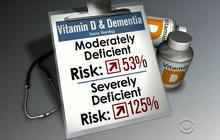Low vitamin D levels are linked to a greater risk of bone fractures in women after menopause — but taking high doses of supplements is not the answer, according to new research.
A study published online Monday in JAMA Internal Medicine suggests the common practice of prescribing vitamin D supplements to fill the gap does not have any benefit for older women’s bones or muscle strength.
“While high-dose vitamin D did indeed increase calcium absorption, the increase was only 1 percent and [it] did not translate into gains in spine, hip or total body bone mineral density,” study author Dr. Karen Hansen, an associate professor of medicine at the University of Wisconsin School of Medicine and Public Health in Madison, told HealthDay. Her team “did not find any benefit of vitamin D, in either high or low dose, on muscle mass, two tests of muscle fitness or fall.”
The study included 230 women younger than 75, but past menopause, who had low vitamin D levels. The women did not have risk factors for other kinds of bone complications. They were divided into three groups and given various doses of vitamin D3, or cholecalciferol, over a year: none (placebo), 800 IUs daily (low-dose) and 50,000 IUs twice monthly (high-dose).
Although the high-dose supplement group achieved the goal of raising their vitamin D levels to 30 nanograms per milliliter, they did not show any benefit in bone density testing, muscle strength measures or a sit-and-stand test, which assesses risk for falls.
Long-standing debates about what level of vitamin D should be the baseline — 20, 25 or 30 nanograms per milliliter — in addition to how much supplementation is necessary have limited attempts to set recommendations for vitamin D. Researchers say the results of this study are more evidence that the higher level is unwarranted for post-menopausal women.
In an editor’s note published in the same journal, Dr. Deborah Grady, a professor of medicine at the University of California, San Francisco, and deputy editor of JAMA Internal Medicine, writes, “It is possible that treatment beyond 1 year would result in better outcomes, but these data provide no support for use of higher-dose cholecalciferol replacement therapy or indeed any dose of cholecalciferol compared with placebo.”
“I think this is the final, and negative, word on vitamin D supplementation,” Dr. Rita Redberg, a professor of medicine with the University of California, San Francisco’s Philip R. Lee Institute for Health Policy Studies and editor of JAMA Internal Medicine, told HealthDay. “There are a lot of women getting vitamin D blood tests and taking vitamin D supplements of various doses. This study suggests that those practices should stop. In other words, if you are going to start vitamin D to improve bone health, and if you are currently taking it for that reason, you can stop. I know of no other benefits for vitamin D supplementation.”
Vitamin D is the companion to calcium, working to help the body utilize more of the mineral necessary to strengthen bones and help muscles function. The amount of vitamin D is less important than how much is “bio-available,” or readily absorbed. The NIH says there is some risk that too much vitamin D in the bloodstream can cause digestive problems and kidney damage, though complications are rare.
In addition to added risk for bone fractures and falls in older adults, low levels of vitamin D have been associated with higher risk of cardiac disease, dementia and Alzheimer’s disease.
The U.S. Preventative Services Task Force does not recommend vitamin D supplements to prevent fractures and falls in post-menopausal women until age 65 or older.
And ongoing research suggests that people of various races, ages or sexes may need different amounts of vitamin D because their bodies absorb and produce the vitamin differently.
Although vitamin D is called the “sunshine vitamin” because it is most easily produced through skin exposure to the sun, doctors caution against extra UV exposure through sun or tanning beds because it raises the risk of skin cancer.
Vitamin D is also found in foods like fatty fishes, some whole grains, eggs and dairy products that are fortified with added vitamin D. Recommended dietary allowances for the vitamin are between 400-800 IU per day and this study does not affect those baseline recommendations.
Vitamin D supplements don’t protect bones of older women, study finds – CBS News.
